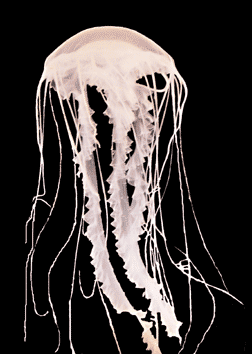Taking the Sting Out of Summer
Your guide to sea nettle remedies
by Jane Elkin
Summer and water sports. In Maryland they go together like boardwalk fries and vinegar — until the arrival of the sea nettles. Tangle with them and you may be reaching for that vinegar to sprinkle on your tender skin.
Vinegar is just one among dozens of folk remedies long touted by self-proclaimed jellyfish sting experts. Depending on who you ask, the magic bullet is probably already in your house or yard. Check the kitchen for baking soda, meat tenderizer, papaya, lemon juice, apple juice, olive oil, tea, coca cola or sugar. Some find relief in the medicine chest with rubbing alcohol, shaving cream, baby powder, antihistamines, analgesics, anesthetics or hydrocortisone creams. Earthier types swear by urine, mud, sand, medicinal clay, activated charcoal, aloe and assorted vitamins and herbal supplements.
All of these remedies have one thing in common: None has been scientifically tested on our local breed of sea nettles.
Over 100 varieties of jellyfish flourish worldwide, and research suggests that many of their stings react differently to the same treatment agents. Thus a folk remedy that is purported to work on a Hawaiian box jellyfish sting, for example, may exacerbate a Portugese man o’ war sting and be useless for the sting of a sea nettle.
An international doctors’ health conference last October in Australia concluded that “Many therapies currently used for jellyfish envenoming are based on anecdote and may be harmful.”
Read on, for now’s the time to find the right remedy.
Now arriving in local waters are our familiar white Chrysaora quinquecirrha, sporting maroon markings in saltier water. Find forecasts, follow “near-real time maps of sea nettle distribution” at the National Oceanic and Atmospheric Administration website Mapping Sea Nettles in the Chesapeake Bay: http://coastwatchnoaa.gov/seanettles/.
Here you’ll also find current salinity levels. Nettles prefer a salty 10 to 20 ppt, though they can survive in five to 30 ppt. Salinity at Sandy Point averages nine ppt in early July.
How Nettlesome
The sea nettle is more populous in the Bay than anywhere else in the world. But as jellyfish go, it is relatively harmless. Considered little more than a painful annoyance, it has not received much scientific attention. Reviewing 10 years of academic jellyfish literature, I turned up fewer than a half dozen studies specific to our local breed. Only one focused on sting preventatives, and none tested remedies.
According to one medical journal, 500,000 envenomations are reported annually in Chesapeake Bay. Yet serious complications are rare. The most vulnerable victims are small children, the elderly and people with a heightened sensitivity due to repeated exposure or allergic reactions. Most sting victims report 15 minutes of intense burning pain followed by a day or two of redness and swelling.
Some also report coughing, a watery nasal discharge or a burning sensation in the throat. In one extreme case, a man developed glaucoma four years after being stung in the eye. Because of the sensitivity of the eyes, all that can be done is to flush with lots of fresh water.
Your best bet for other parts of the body is to follow the standard protocol for jellyfish stings.
Treating the Sting
Whatever the species and specific topical remedy for its sting, treatment follows a three-step process: removal, remedy, repair.
sting, treatment follows a three-step process: removal, remedy, repair.
Removal: If you are stung, remain calm, leave the water and gently remove tentacles to avoid further stings.
Jellyfish tentacles have little barbs called nematocysts that hook the skin and inject venom. Many experts recommend using a towel or stick to remove tentacles. Sea nettle researchers insist that the hand’s thickened palms are not sensitive enough to suffer from direct contact.
Some sources recommend further removal of nematocysts, after a remedy has been applied, by scraping the area with sand and a credit card. The pain of sea nettle stings is so short-lived it is probably not worth the trip home for shaving cream and a razor, which are often suggested in the case of more serious stings.
Remedy: Apply something to the burned skin.
Logic dictates that if one is comparing apples to apples, i.e. focusing on remedies for sea nettle stings only, there should be some agreement. Yet there is not. In 16 sources ranging from magazine articles to area medical and pharmacological professionals, marine biologists, sportsmen and tourism bureaus, I saw some trends but found no definitive answers.
Suggestions vary from heat or cold therapy to topical applications to counteract or draw out the stingers.
Repair: If soreness and inflammation continue, they can be treated topically with hydrocortisone cream or anesthetics such as benzocaine or lanacaine. Herbalists also recommend aloe; crushed comfrey leaves; a paste of activated charcoal or medicinal clay; or vitamin E.
But With What?
Many people interviewed for this article refused to recommend a remedy or insisted that there are no useful remedies. Trends emerged, if not resounding endorsements.
Of 10 sources recommending a specific topical application other than water, 60 percent approved of baking soda and meat tenderizer. Baking soda mixed with sea water forms an astringent paste that helps dry out the wound and therefore withdraw unfired nematocysts from the skin. Meat tenderizer, on the other hand, attacks the protein structure of nematocysts, rendering them inert. Take care not to leave it on the skin for more than 15 minutes, as it can cause a rash.
The key ingredient in meat tenderizer is papain, which is found in papaya, and that is why two sources recommend bringing fresh papaya to the beach and simply applying slices directly to a sting. So in effect, papaya, meat tenderizer or a paste of powdered papain (available in health food stores), are the same suggestion, with an 80 percent approval rating.
One-fourth of experts recommend simply rinsing with water, though they do not agree on the type of water: 88 percent preferred sea water to fresh water. That’s because each has a different pressure, and the change from sea to fresh water could trigger unfired nematocysts in the skin, causing more damage.
Alcohol and vinegar, common folk remedies for several tropical species of jellyfish, were only half as popular as baking soda or meat tenderizer as a remedy for sea nettles, and then only as a substitute. Alcohol, like baking soda, has astringent properties. So does a paste of baby powder, which one source recommends. Vinegar seems most risky of these four suggestions, because it reacts differently with different types of jellyfish and has not been tested specifically on sea nettles.
In the debate over heat or cold therapy, cold is preferred by a slim majority for all types of jellyfish and sea nettles in particular. Dr. Valerie Nix, a naturopath in Severna Park, says this complex issue is often misunderstood because icing, in order to be effective, must be continued until the skin is numb. Otherwise it will exacerbate the problem.
An Ounce of Prevention
If you are planning to be in the water a lot, regardless of jellyfish populations, prevention is the best medicine. Lightweight protective clothing, pantyhose, wetsuits or a slathering of petroleum jelly are old standbys, but no one wants to go to the beach dressed like that.
Fortunately there is another option. Safe Sea lotion, available with or without sunblock, uses the same substance that makes clownfish immune from sea anemone stings, and it is clinically proven effective against sea nettles. In a double blind study of a dozen volunteers who applied this product before immersing their arms in a tank of sea nettles, none experienced any visual change to the skin, and only two felt mild discomfort.
Boaters may want to consider purchasing a Nettle Net boat pool, available in sizes from eight to 20 feet wide. It features an inflatable lip attached to a deep pocket of mosquito netting that guarantees protection while swimming.
One final option for the serious water lover is herbal supplements to increase overall immunity so that stings are not felt so severely. Shiitake and reishi mushrooms, chlorophyll, echinacea, bioflavonoids, astragulus, Siberian ginseng and vitamin C are all mentioned in the generic literature.
A final caution: The most memorable folk remedy of all, urine, is a bad idea. Only rumored to work on Hawaiian box jellies, it is unlikely to be effective on sea nettles and could actually cause infection. Save yourself the humiliation.
